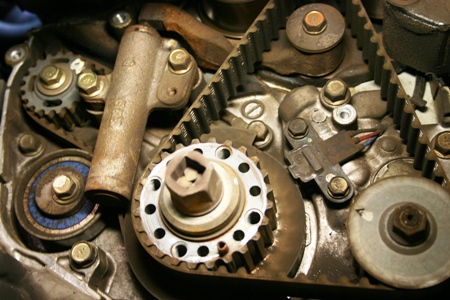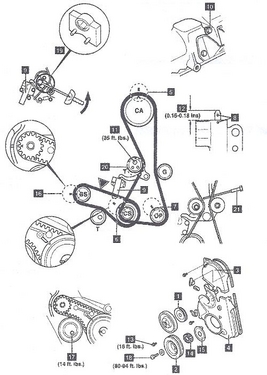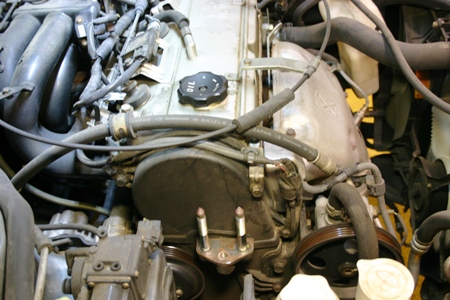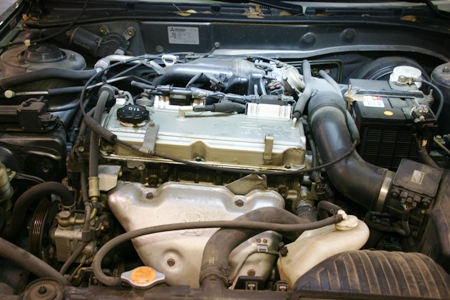Timing Belt Replacement 2.4 Mitsubishi – Questions and Answers
August 29, 2009 1:46 pm DIY, How To Auto Repair, Mistubishi, Timing Belt© DenLorsTools.com Summary: In this automotive repair article we cover timing belt R&R instructions on the Mitsubishi 2.4 L SOHC engine and the recommended replacement interval. We list the different makes and models that use this particular engine. Automotive repair questions and answers are included along with a diagram for timing belt marks.
The Mitsubishi 2.4 Liter SOHC engine is used in the Eclipse, Galant and Outlander. Many people are unaware that the engine is also used in the Chrysler Sebring and Dodge Stratus. It’s important to know that the 2.4 is an interference engine that may end up with bent valves and possibly damaged pistons if the timing belt strips or breaks during driving. The motor includes a main timing belt and a smaller balance shaft belt. Both of these should be replaced at the same time. The manufacturer recommended replacement interval is every 60,000 miles.
The job of replacing the timing belts on just about any engine is basically the same, regardless of which vehicle it is in.
There are several precautions keep in mind. It’s always best to disconnect the battery’s ground cable, do not turn the crank shaft or camshaft with the timing belt removed. Some people prefer to remove the spark plugs to make the engine easier to turn although this is not necessary. Turn the crank shaft in the normal direction of rotation which is clockwise. Do not try to turn the crankshaft by turning the camshaft bolt. It’s always best to use tightening torque specifications provided by the manufacturer.
1. Raise and support the vehicle. If doing this at home use a floor jack and jack stands for safety. Then the right front wheel is removed and then the splash shield. It‘s easiest to loosen the water pump bolts before removing the accessory belts, otherwise the entire pulley will turn. Then remove the alternator, AC and power steering belts. After the belts are removed the upper timing cover can be taken off.
2. Always start with the engine at top dead center compression stroke with the timing marks aligned. Find top dead center by removing the #1 spark plug which is closest to the front of the engine and placing a screwdriver or 1/4″ extension down the hole. Turn the crank slowly and make sure it doesn’t bind – when the tool that was inserted reaches the highest point, top dead center is reached. Verify with marks.
3. Toward the engine with a block of wood on the floor jack positioned underneath the oil pan. Once the engine is lifted up slightly a motor mount can then be removed.
4. Leave the main crankshaft bolt in place. Remove the smaller bolts holding the crank pulley in place pulley to the side. Then remove the lower timing belt cover.
5. Now look for the timing belt marks and make sure they are aligned. I recommend making some of your own marks as well with white touch up paint or white out. Of course this will not be possible if replacing a broken or stripped belt. But when replacing a belt for maintenance I like the additional assurance, that the extra marks give me.
6. The main belt’s tensioner is hydraulic. The 12 mm bolts are removed and then he tensioner can be placed in a bench vice to be compressed. The pin to hold a tensioner in place is sometimes referred to by mechanics as grenade pins. Sometimes a small drill bit can be used instead of the specific pin. If you are replacing a tensioner it will come with the correct pin. 
7. Remove the main timing belt then the balance shaft belt can be removed. It may be necessary to take the crankshaft position sensor off slightly turning the crank to remove the small belt. Be careful not to bend the shield (reluctor) at the back of the pulley this can affect the reading crank shaft position sensor. It some cases it may be necessary to remove the large crank bolt and slide the timing belt pulley and the reluctor out slightly.
8. Now is a good time to replace any pulleys that show any signs of wear. Spin the pulleys to check them for smoothness and side movement. If a tensioner or idler pulley freezes up it can cause a new timing belt to fail. If there are any signs of oil leaks from the seals now is the time to replace cam and crank seals if necessary. At this point you are right at the water pump so replacing that should also be consideration.
Replacement is basically reversing the procedure above. 2.4 Mitsubishi Engines are used in the following vehicles. Mitsubishi Eclipse 1999, 2000, 2001, 2002, 2003, 2004 & 2005 – Galant 99,00,01, 02, 03, 04 & 05 – Outlander 2003 Chrysler Sebring 2001, 02, 03, 04 & 2005 – Dodge Stratus 2001, 02, 03, 04 & 05 
For a large pdf of the timing belt marks click the image above.
Timing Belt Replacement Questions and Answers
Question: Is there any special holding tool needed like I’ve seen for Honda’s to remove the main timing belt pulley bolt on the crankshaft?
Answer: No. Just a regular 1/2″ impact gun works well to remove the bolt on the Mitsubishi.
Question: If replacing a crank seal while I’m doing this job is there anything I should be aware of?
Answer: Yes. Be careful NOT to scratch the crankshaft with a screwdriver or whatever you use to remove the seal. It also should be cleaned well with brake clean prior to installing the new seal. Some techs will use a little emery paper to help clean the contact surface, but it’s important to use very fine paper so as not to leave grooves that can wear the seal prematurely. Also when installing the new seal be careful not to fold the rubber that holds the spring. Engine oil or a little sil glyde (silicone paste) can be used to help lubricate the seal until oil gets pumped to it.
Question: The seal is very difficult to remove. Have any removal tips?
Answer: I have used a very small drill bit to allow a sheet metal screw to be inserted. After the sheet metal screw is in place it can be pulled with diagonal cutters, pulling the seal with it. This works but caution should be taken not to scratch the crank and to not allow any metal shavings to be left in the engine.
Question: Can I use a cylinder leak down tester to see if my broken timing belt has caused valve damage?
Answer: Yes and no. If testing an engine that has a broken timing belt with a leak down tester, you will get an inaccurate reading because the valves are not in sync. You can however test the integrity of the valves after a timing belt is installed properly (if a timing belt is off a tooth, the cylinders can leak down).
Question: My timing belt broke while driving down the road. How do I know if the engine has valve damage?
Answer: Inspecting the tops of the pistons with a borescope or a video inspection camera can be a quick easy way to see if the valves interfered with the pistons. Most technicians would just try a timing belt and see how the car runs. If the car starts but has a misfire or runs poorly, this would be an indication that the valves are bent. Also sometimes in the process of replacing the t-belt it may be discovered that the cam will not turn which can also indicate bent valves. Remember don’t try to force the cam with the belt off since that can cause damage in itself.


Joseph :
Date: July 19, 2017 @ 7:46 am
1. Please what is the timing belt number of mitsubishi galant LS 1995 2.4 ltr.?
2. Recently, I changed the damaged spark plugs cable of my Mitsubishi galant and ever since the vehicle refuses to start….What could be the cause?
dennisb - Auto Tool Sales :
Date: July 19, 2017 @ 7:54 am
Check with the Mitsubishi dealer for a part number on the belt, I have no way to look parts up. If your timing is set up properly you could have bent valves.
Jesus :
Date: August 7, 2017 @ 4:29 pm
Mitsubishi galant engine2.4l
dennisb - Auto Tool Sales :
Date: August 7, 2017 @ 4:36 pm
That’s right.